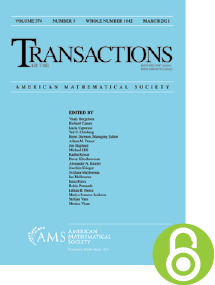New combinatorial interpretations of Ramanujan’s partition congruences mod $5,7$ and $11$
HTML articles powered by AMS MathViewer
- by F. G. Garvan PDF
- Trans. Amer. Math. Soc. 305 (1988), 47-77 Request permission
Abstract:
Let $p(n)$ denote the number of unrestricted partitions of $n$. The congruences referred to in the title are $p(5n + 4)$, $p(7n + 5)$ and $p(11n + 6) \equiv 0$ ($\bmod 5$, $7$ and $11$, respectively). Dyson conjectured and Atkin and Swinnerton-Dyer proved combinatorial results which imply the congruences $\bmod 5$ and $7$. These are in terms of the rank of partitions. Dyson also conjectured the existence of a "crank" which would likewise imply the congruence $\bmod 11$. In this paper we give a crank which not only gives a combinatorial interpretation of the congruence $\bmod 11$ but also gives new combinatorial interpretations of the congruences $\bmod 5$ and $7$. However, our crank is not quite what Dyson asked for; it is in terms of certain restricted triples of partitions, rather than in terms of ordinary partitions alone. Our results and those of Dyson, Atkin and Swinnerton-Dyer are closely related to two unproved identities that appear in Ramanujan’s "lost" notebook. We prove the first identity and show how the second is equivalent to the main theorem in Atkin and Swinnerton-Dyer’s paper. We note that all of Dyson’s conjectures $\bmod 5$ are encapsulated in this second identity. We give a number of relations for the crank of vector partitions $\bmod 5$ and $7$, as well as some new inequalities for the rank of ordinary partitions $\bmod 5$ and $7$. Our methods are elementary relying for the most part on classical identities of Euler and Jacobi.References
- George E. Andrews, Applications of basic hypergeometric functions, SIAM Rev. 16 (1974), 441–484. MR 352557, DOI 10.1137/1016081
- George E. Andrews, The theory of partitions, Encyclopedia of Mathematics and its Applications, Vol. 2, Addison-Wesley Publishing Co., Reading, Mass.-London-Amsterdam, 1976. MR 0557013
- George E. Andrews, An introduction to Ramanujan’s “lost” notebook, Amer. Math. Monthly 86 (1979), no. 2, 89–108. MR 520571, DOI 10.2307/2321943
- George E. Andrews, Partitions: yesterday and today, New Zealand Mathematical Society, Wellington, 1979. With a foreword by J. C. Turner. MR 557539
- George E. Andrews, Hecke modular forms and the Kac-Peterson identities, Trans. Amer. Math. Soc. 283 (1984), no. 2, 451–458. MR 737878, DOI 10.1090/S0002-9947-1984-0737878-3
- George E. Andrews, Generalized Frobenius partitions, Mem. Amer. Math. Soc. 49 (1984), no. 301, iv+44. MR 743546, DOI 10.1090/memo/0301
- A. O. L. Atkin and P. Swinnerton-Dyer, Some properties of partitions, Proc. London Math. Soc. (3) 4 (1954), 84–106. MR 60535, DOI 10.1112/plms/s3-4.1.84
- A. O. L. Atkin and S. M. Hussain, Some properties of partitions. II, Trans. Amer. Math. Soc. 89 (1958), 184–200. MR 103872, DOI 10.1090/S0002-9947-1958-0103872-3
- A. O. L. Atkin, A note on ranks and conjugacy of partitions, Quart. J. Math. Oxford Ser. (2) 17 (1966), 335–338. MR 202688, DOI 10.1093/qmath/17.1.335
- A. O. L. Atkin, Note on a paper of Cheema and Gordon, Duke Math. J. 34 (1967), 57–58. MR 207671
- A. O. L. Atkin, Proof of a conjecture of Ramanujan, Glasgow Math. J. 8 (1967), 14–32. MR 205958, DOI 10.1017/S0017089500000045
- M. S. Cheema and Basil Gordon, Some remarks on two- and three-line partitions, Duke Math. J. 31 (1964), 267–273. MR 160770, DOI 10.1215/S0012-7094-64-03125-4 F. J. Dyson, Some guesses in the theory of partitions, Eureka (Cambridge) 8 (1944), 10-15.
- F. G. Garvan, A simple proof of Watson’s partition congruences for powers of $7$, J. Austral. Math. Soc. Ser. A 36 (1984), no. 3, 316–334. MR 733905, DOI 10.1017/S1446788700025386 —, Generalizations of Dyson’s rank, Ph. D. thesis, Pennsylvania State University, 1986, 127 pp.
- Michael D. Hirschhorn and David C. Hunt, A simple proof of the Ramanujan conjecture for powers of $5$, J. Reine Angew. Math. 326 (1981), 1–17. MR 622342, DOI 10.1515/crll.1981.326.1
- M. D. Hirschhorn, A simple proof of an identity of Ramanujan, J. Austral. Math. Soc. Ser. A 34 (1983), no. 1, 31–35. MR 683175, DOI 10.1017/S1446788700019728 —, A generalization of Winquist’s identity and a conjecture of Ramanujan, J.I.M.S. Ramanujan Centenary Volume. J. N. O’Brien, Some properties of partitions with special reference to primes other than $5$, $7$ and $11$, Ph. D. thesis, Univ. of Durham, England, 1966, 95 pp. S. Ramanujan, Some properties of $p(n)$, the number of partitions of $n$, Paper 25 of Collected Papers of S. Ramanujan, Cambridge Univ. Press, London and New York, 1927; reprinted: Chelsea, New York, 1962.
- J. J. Sylvester and F. Franklin, A Constructive Theory of Partitions, Arranged in Three Acts, an Interact and an Exodion, Amer. J. Math. 5 (1882), no. 1-4, 251–330. MR 1505328, DOI 10.2307/2369545 G. N. Watson, A new proof of the Rogers-Ramanujan identities, J. London Math. Soc. 4 (1929), 4-9. —, Ramanujans Vermutung über Zerfällungsanzahlen, J. Reine Angew. Math. 179 (1938), 97-128.
- Lasse Winquist, An elementary proof of $p(11m+6)\equiv 0\,(\textrm {mod}\ 11)$, J. Combinatorial Theory 6 (1969), 56–59. MR 236136, DOI 10.1016/S0021-9800(69)80105-5
Additional Information
- © Copyright 1988 American Mathematical Society
- Journal: Trans. Amer. Math. Soc. 305 (1988), 47-77
- MSC: Primary 11P76; Secondary 05A17, 05A19
- DOI: https://doi.org/10.1090/S0002-9947-1988-0920146-8
- MathSciNet review: 920146


